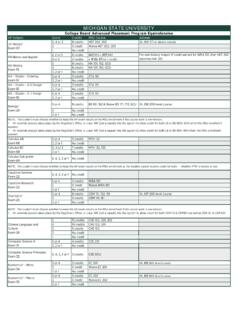Transcription of Evaluation of FETAC qualifications
1 Evaluation of QQI FET/ FETAC qualifications Applicants should consult HEI literature to establish how QQI FET/ FETAC level 5/6 awards, now made by Quality and qualifications Ireland (QQI), are assessed. QQI FET/ FETAC level 5/6 major awards are made up of a number of component awards. Different sets of components may lead to different major awards. Some courses require specific major awards. It is important to know which major awards are accepted for entry to these courses. For certain courses in Higher Education Institutions (HEIs) there is a reserved quota of places for applicants presenting QQI FET/ FETAC level 5/6 awards. Such applicants compete for these places separately from all other applicants. Details are shown in the HEI prospectus.
2 You may also refer to the QQI FET/ FETAC section of the CAO website The description below is based on the structure of the CAS awards introduced by QQI FET/ FETAC in 2012. For awards under the previous structure, QQI will provide CAO with scores in the format described here. 1. Applicants must have obtained a full QQI FET/ FETAC Level 5/6 major award. A Component Certificate will not suffice. A full QQI FET/ FETAC major award normally contains 8 components. A major award may be accumulated over more than one academic year. In such cases, it is the responsibility of the applicant to apply to QQI FET/ FETAC for a major award where courses are taken over more than one year. 2. Certain courses may require specific achievements in particular specific modules ( Distinction or Merit or Pass) within the QQI FET/ FETAC level 5/6 major award.
3 Some courses may require a minimum set of achievements, 5 Distinctions, or 2 Distinctions and 1 Merit - see HEI prospectuses and the QQI FET/ FETAC section of the CAO website for details of such specific requirements. 3. If an applicant has the required major award and any specified required component awards then points will be calculated according to the formula below. 4. If an applicant is presenting only QQI FET/ FETAC level 5/6 results, the QQI FET/ FETAC level 5/6 score is retained for further rounds in the event that a vacancy might arise in the quota for QQI FET/ FETAC level 5/6 applicants. 5. Applicants presenting QQI FET/ FETAC level 6 awards should contact the relevant HEI for information on the admissions process.
4 Outline of the QQI FET/ FETAC scoring scheme in use by all HEIs from 2017 This scoring scheme only applies where all the requirements for the major award are met, when the named component awards specified have been achieved to a minimum of 120 credits. Each component is given a score based on the credit value of the component and the weighting of the grade achieved. Most component awards have a credit value of 15 (the possible component credit values are 5, 10, 15, 20 and 30). The following weightings will apply to the grades achieved: pass=1, merit=2, distinction=3. To calculate a component score, multiply the credit value of the component by the weighting for the grade achieved. Add all of the component scores up to a cumulative credit value of 120.
5 When adding up these scores begin with distinctions, then merits, then passes. Finally, multiply the total by 13 and divide by 12 to give the overall score (maximum 390). * Examples of the QQI FET/ FETAC scoring scheme in use by all HEIs from 2017 In these examples distinction = D, merit = M, pass = P. 1. In this example the applicant has 9 distinctions (DDDDDDDDD). All of her components have a credit value of 15. The table below shows the steps required to calculate the overall score. Begin by listing the components in grade order DDDDDDDDD. Step 1 grade D D D D D D D D D 2 Credit Value 15 15 15 15 15 15 15 15 15 3 Cumulative credit value (max=120) 15 30 45 60 75 90 105 120 n/a 4 Credit value for scoring (max = 120) 15 15 15 15 15 15 15 15 0 5 Weighting 3 3 3 3 3 3 3 3 n/a 6 Weighting x Credit Value 3x15 3x15 3x15 3x15 3x15 3x15 3x15 3x15 n/a 7 Add the results 45 45 45 45 45 45 45 45 =360 She has 135 credits and can only count 120 for scoring purposes, so eliminate 15 credits with the least value eliminate one of the distinctions.
6 Now multiply 360 by 13 and divide by 12 = 390. 2. In this example the applicant has 7 distinctions (DDDDDDD). His components have various credit values. The table below shows the steps required to calculate the overall score. Begin by listing the components in grade order DDDDDDD. Step 1 grade D D D D D D D 2 Credit Value 30 30 15 15 15 15 15 3 Cumulative credit value (max=120) 30 60 75 90 105 120 n/a 4 Credit value for scoring (max = 120) 30 30 15 15 15 15 0 5 Weighting 3 3 3 3 3 3 n/a 6 Weighting x Credit Value 3x30 3x30 3x15 3x15 3x15 3x15 n/a 7 Add the results 90 90 45 45 45 45 =360 He has 135 credits and can only count 120 for scoring purposes, so eliminate 15 credits with the least value eliminate one of the distinctions with a credit value of 15.
7 Now multiply 360 by 13 and divide by 12 = 390. 3. In this example the applicant has 4 distinctions, 2 merits and 2 passes. Her components have various credit values. The table below shows the steps required to calculate the overall score. Begin by listing the components in grade order DDDDMMPP. Step 1 grade D D D D M M P P 2 Credit Value 30 15 15 10 30 15 15 15 3 Cumulative credit value (max = 120) 30 45 60 70 100 115 130 over max of 120 n/a 4 Credit value for scoring (max = 120) 30 15 15 10 30 15 5 0 5 Weighting 3 3 3 3 2 2 1 n/a 6 Weighting x Credit Value 3x30 3x15 3x15 3x10 2x30 2x15 1x5 7 Add the results 90 45 45 30 60 30 5 =305 She has 145 credits and can only count 120 for scoring purposes, so eliminate 25 credits with the least value eliminate one of the passes and calculate a score for 5 credits of the remaining pass.
8 Now multiply 305 by 13 and divide by 12 and round the result to the nearest whole digit = 330. 4. In this example the applicant has 4 distinctions, 2 merits and 2 passes. His components have various credit values. The table below shows the steps required to calculate the overall score. Begin by listing the components in grade order DDDDMMPPP. Step 1 grade D D D D M M P P P 2 Credit Value 15 15 10 10 15 15 15 15 15 3 Cumulative credit value (max=120) 15 30 40 50 65 80 95 110 125 over max of 120 4 Credit value for scoring (max = 120) 15 15 10 10 15 15 15 15 10 5 Weighting 3 3 3 3 2 2 1 1 1 6 Weighting x Credit Value 3x15 3x15 3x10 3x10 2x15 2x15 1x15 1x15 1x10 7 Add the results 45 45 30 30 30 30 15 15 10 =250 He has 125 credits and can only count 120 for scoring purposes, so eliminate 5 credits with the least value calculate a score for 10 credits of the last pass.
9 Now multiply 250 by 13 and divide by 12 and round the result to the nearest whole digit = 271.














